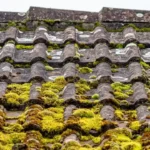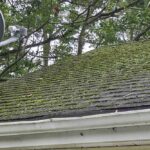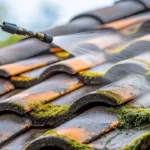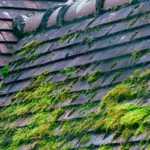When it comes to maintaining your home, your roof is one of the most crucial elements. It’s not just about keeping the rain out; it’s about ensuring the overall health of your home. A frequent question that arises is, does moss damage roof shingles? This is an important question for homeowners, especially those living in humid or wooded areas where moss tends to thrive.
Moss can be a charming addition to your garden, but when it comes to your roof, it can be a different story. The aesthetic appeal of moss is quickly overshadowed by the potential damage it can cause to your roof shingles. In this article, we’ll delve into how moss affects roof shingles, why it grows there, and what you can do to prevent it.

Understanding Moss Growth on Roofs
Moss is a simple, non-vascular plant that thrives in damp, shady environments. Roofs, particularly those under trees or in shaded areas, provide an ideal environment for moss growth. Once moss finds a foothold on your roof, it can spread quickly.
Why Does Moss Grow on Roofs?
Moss grows on roofs primarily due to moisture and shade. Roofs that receive little sunlight and retain moisture, especially after rain, are more susceptible. Overhanging trees can exacerbate this issue by providing additional shade and dropping debris that retains moisture.
The Impact of Moss on Roof Shingles
The primary concern with moss on roof shingles is its ability to retain moisture. Moss holds water against the roof surface, which can lead to a variety of problems:
Moisture Retention
Moss acts like a sponge, soaking up and holding water. This constant moisture against the shingles can lead to the deterioration of the roofing material, affecting its integrity and lifespan.
Shingle Damage
As moss grows, it can lift shingles, allowing water to seep underneath. This can cause the underlying materials to rot and lead to leaks inside the home.
Structural Damage
Over time, the presence of moss can lead to significant damage, potentially compromising the structure of the roof itself. This can result in costly repairs or even necessitate a complete roof replacement.
Preventing Moss Growth
Preventing moss growth on your roof is crucial for maintaining its health and longevity. Here are some effective strategies:
Regular Cleaning
Regular roof maintenance and cleaning can prevent moss from taking hold. This includes removing debris and ensuring gutters are clear to prevent water accumulation.
Trimming Overhanging Branches
Keeping trees trimmed back can reduce shade and allow more sunlight to reach the roof, helping to keep it dry.
Installing Zinc or Copper Strips
Metal strips can be installed along the roof ridge. When it rains, metals like zinc or copper leach out, creating an environment that is inhospitable to moss.
How to Remove Moss from Roof Shingles
If moss has already taken hold, it’s important to remove it carefully to avoid damaging the shingles further. Here are some steps you can take:
Manual Removal
Using a soft brush or broom, gently remove the moss. Avoid using pressure washers or harsh scraping tools that can damage the shingles.
Chemical Treatments
There are several chemical treatments available that can effectively kill moss. It is important to choose products that are safe for your roofing material.
Professional Help
If the moss is extensive or you’re unsure how to proceed, hiring a professional roofing contractor can ensure the moss is removed safely and effectively.
Long-Term Solutions
For long-term prevention, consider investing in roofing materials that are resistant to moss growth. Some shingles are specially designed to resist moisture and moss accumulation. Choosing the right roofing material can save time and money in the long run.
For more detailed information on moss issues and dangers, visit our comprehensive guides.
Environmental Considerations
While moss can be damaging, its important to consider the environmental impact of removal methods. Some treatments can harm plants or animals, so choosing eco-friendly options can be beneficial.
Conclusion
So, does moss damage roof shingles? The answer is a resounding yes. While moss may seem harmless, its ability to retain moisture and cause structural damage makes it a significant concern for homeowners. By understanding why moss grows and taking proactive steps to prevent and remove it, you can protect your roof and maintain the integrity of your home.
For additional tips on maintaining your roof, visit moss growth insights and flood-prone areas solutions.

Frequently Asked Questions
Can moss damage all types of roof shingles?
Yes, moss can potentially harm all types of shingles, but some materials are more susceptible than others. Asphalt shingles, for example, can be particularly vulnerable to moss damage.
Is it safe to use bleach to remove moss from my roof?
While bleach can be effective in killing moss, it can also damage roofing materials and harm surrounding plants. It’s best to use products specifically designed for roof moss removal.
How often should I check my roof for moss?
Regular roof inspections, ideally twice a year, can help catch moss growth early and prevent extensive damage.
For more insights on roof maintenance, visit moss issues and evidence discussion.
This article contains affiliate links. We may earn a commission at no extra cost to you.








